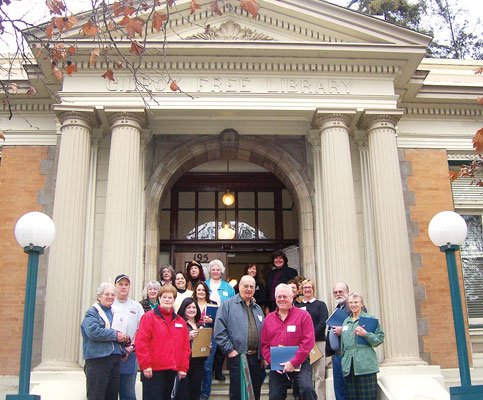You are invited to a party this coming Saturday as the
impressive classical style building on Fifth Street now housing the
Gilroy Museum celebrates its 100th anniversary. Volunteers at the
museum, which will be draped in colorful bunting, will provide
refreshments on the lawn and tours of the building, including the
mysterious basement where the museum got its start. The tours will
point out the building’s antique and unique architectural features,
such as beautiful woodwork, marble fixtures, and gas lighting. The
dumbwaiter, which used to bring books up from the basement, also
will be on display and guests will receive souvenir posters, pens
and pencils.
You are invited to a party this coming Saturday as the impressive classical style building on Fifth Street now housing the Gilroy Museum celebrates its 100th anniversary. Volunteers at the museum, which will be draped in colorful bunting, will provide refreshments on the lawn and tours of the building, including the mysterious basement where the museum got its start. The tours will point out the building’s antique and unique architectural features, such as beautiful woodwork, marble fixtures, and gas lighting. The dumbwaiter, which used to bring books up from the basement, also will be on display and guests will receive souvenir posters, pens and pencils.
“We are hoping for a really big centennial celebration,” which begins at 10 a.m. Saturday, Historical Society President Connie Rogers said.
“As we begin to build our beautiful third library building on Sixth Street, it is a perfect time to celebrate the building that started it all 100 years ago,” Gilroy historian Elizabeth Barratt said.
Back in the early 1900s, it took several years of community discussion and pressure from the Gilroy Advocate’s editor before the City Council passed a resolution to establish Gilroy’s first library.
The next question was where to get construction funding. Gilroy’s Mayor Dunlap heard about grants being given out by Andrew Carnegie, the Scottish-American entrepreneur who built Carnegie Hall. His rags-to-riches success made him the richest steel magnate in U.S. history. During his lifetime, he donated $350 million (well over $4 billion in today’s figures) to charity and educational causes.
Dunlap wrote to Carnegie and received word that Gilroy qualified for a grant of $10,000. However, the council endlessly debated the wisdom of accepting such a grant, what strings were attached, and where the library could be located.
The town’s council members were bogged down in bickering until wealthy widow Caroline Hoxett (who also built Rebekah Children’s Home) stepped forward. She saved the day by proclaiming that they could use the tennis court she purchased for $1,000 on the corner of Fifth and Church Streets.
One of the strings attached to the grant was the requirement that the plans first be approved by Andrew Carnegie’s staff, according to the Gilroy Historical Society. The renowned Central Coast architect William Weeks submitted his blueprints, which went on to serve as the basis for nine other Carnegie libraries in northern California. The contractor, Hiram J. Wood of Watsonville, completed the library for $9,204. The remainder of the grant was used to buy furnishings and books.
On July 27, 1910, the brand new library opened with 1,700 books. Beneath the central skylight rotunda, four archways opened into spacious reading and book rooms. Heavy oak study tables with polished bentwood chairs awaited enthusiastic learners. Modern conveniences included a fireplace and a central heating system fired by coal.
Many Gilroyans have fond memories of visiting the library during their formative years. They remember the smell, their favorite books and the librarian showing them how to re-shelve books.
Exhibits of early American glass went on display in the basement in 1958, and in 1963 the museum was formally established there. Once a larger library was built in 1975, the museum took over the entire Carnegie building. The building was added to the National Register of Historic Places in 1988.
“Going into the Museum reminds me of my childhood hometown – Grand Island, Neb. – where the library was also a Carnegie building,” local teacher Janice Krahenbuhl recalled with a smile on her face. “I wandered about that library building, totally enthralled, for literally hours on my way home from school.”
As a teacher, she has arranged for several thousand students to visit the museum, where they learn about everything from research techniques to Gilroy’s founding. The archives and displays include newspapers from 1868 to present, tax records, family history files, more than 25,000 artifacts, and an amazing collection of photographs of Gilroy. The building’s architectural and library history make it a perfect home to share Gilroy’s civic and cultural heritage with the community.
Thanks to the efforts of Susan Voss and Tom Howard, the museum won grant money from the Institute of Museum and Library Services for a recent professional evaluation, and it was found that the building is in very good shape for being a century old.
Although the museum lost all of its paid employees in layoffs last year, volunteers have kept the museum open. Yet, they need a few more. If interested, please pick up city’s official volunteer form (available at the Museum or www.ci.gilroy.ca.us) and turn the form in to the museum.
A century of civics and culture
-What: Carnegie Library centennial celebration
-When: 10 a.m. to 2 p.m. Saturday
-Where: The Gilroy Museum, located in the Carnegie Library building, at the corner of Fifth and Church streets














